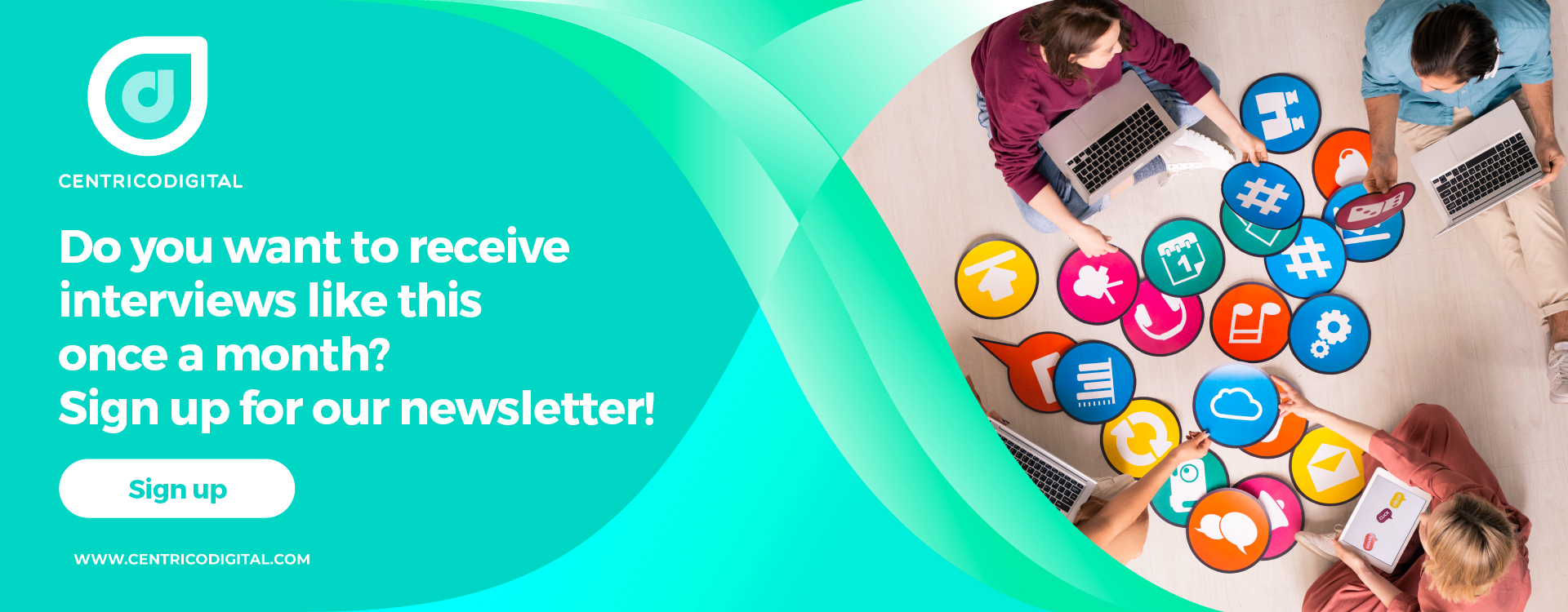Matthew: Hey, David. How are you doing? Thanks so much for taking the time. The basic idea of this interview is to demystify the role of the CMO and the work that happens in a B2B marketing team. What I hope to do today is just really get into the weeds because I know you have extensive experience in this.
David: From a weed’s perspective, your weeds and my weeds may be different. From what I’ve seen on your website and the stuff you talk about, it tends to be leaning towards more of the data side of marketing, where I’m leaning towards more of the relationship side of marketing.
Matthew: What’s been interesting for me in this journey, is that I definitely started on the data side of marketing, and when people think of you, their first reference is Radian6, which, if we think of its role in the ecosystem, was really bringing data to all of these different activities that people were doing in the past. Radian6 helped start to build the conversation around data and social media. I’d love to hear about your journey up to Radian6, and I’d love to hear about what being a relationship-based CMO means to you.
David: Yeah. I’ve had my whole career basically based out of this part of Canada that many people around the world may not even really know a heck of an about. In the Maritimes of Canada, it’s a pretty relatively small population.
Prior to Radian6, I’d always been in marketing or technology. For me, Radian6 was used as a platform where you could discover how many people were talking about you, whether there was a spike in terms of conversations about certain topics, and so on and so forth. It allowed you to measure.
But the part that I got excited about was the ability to actually find people that are passionate about the same thing you are. It was an easier way to discover people as opposed to the numbers in the end.

Matthew: Yeah. I find that really interesting because our stories started in the same place. After I left Atlantic Canada, I ended up in Silicon Valley, which is kind of a bubble. Everything is metrics-driven and data-driven. If you could pull on that thread a little bit, how has working outside of the Silicon Valley bubble has influenced the way you think about your work?
David: One thing about living two hops away from major centers, having a small population, being out of the bubble, is that you have to work 10 times harder to make sure you think of every single possible approach to every problem, and the solutions have to have multiple backup plans. I’m not saying the bubble would have been an easy road but there’s generally no easy road to anything. The good news about that is if you can solve a problem in an environment where everything requires more effort, then you know that you’ve got a pretty solid solution to something. Generally, anyone outside of Silicon Valley probably has the same thing running through their minds: “What do we do? How do we build a brand outside of a bubble?”
The other advantage I think we have is the fact that the bubble tends to be skewed. Since people tend to think that inside the bubble, this is the way the rest of the world thinks. When you grow a business outside of that, you have to listen more, which again, part of the Radian6 platform was making sure you listened to what people were saying, understanding them, and developing a relationship so they could share a deeper understanding with you. We focused on that.
Matthew: Yeah. I find that fascinating.
I think one of the things that helps break those bubbles is migration and travel.
Do you think that there’s an argument to be made that our history of migration and movement (in Atlantic Canada) is enabling these companies to now thrive and think differently in spaces that, maybe at one point, were not the mainstream?
David: If you think about where all of us in the entire globe is right now, in the middle of a pandemic, the concepts of “you have to live where you work”, and “you have to live close to the people that you work with,” have been thrown out the window.
I really think that when it comes to building something that is going to be a world leader, you can do it from anywhere, but you have to be thinking about being global right from the beginning. The one danger that I’ve seen is that when startups start in an area outside of the mainstream, often, they may be a little bit gun shy to go into the bigger markets where the big customers are, where they should be going. They’ll spend some time focusing on customers that are around them.
Matthew: Yeah, It’s interesting because both of the places where I’ve defined my youth and my adulthood are places that tend to be inward-focused, or least used to be. Here in Latin America and Ecuador, I often advise companies– Ecuador is a country of 15 million. If we add Colombia and Peru, which are the next-door neighbors, we have a market of 90 million people. But it’s sometimes very hard to get people to think beyond their borders.
One of the interesting things that you refer to quite frequently is the idea of listening to your customers, talking to your customers, and creating feedback loops. I’d be curious in hearing a little bit about, especially in your accelerator, how you talk to your CMOs and future CMOs about listening to the customer. What does that conversation with them look like?
David: There’s a danger in just saying ‘listening to the customer’. I like to cast the net even wider. Often, people that love your product aren’t necessarily going to be a customer, but they can be someone that is a great advocate for what you’re doing. A CMO should be listening to people that are passionate about the transformation of the industry.
You’re going to be able to look out to the market and say, “Who are the people that are speaking at conferences, writing blogs, being interviewed, re-tweeting, commenting on the topic around this problem that exists between the current state and the future state. Which is better?” If you see those people talking, ideally, you’d want to connect and get to know them because they’re passionate about the transformation. Not only by listening to those people, whether they’re an influencer, or an advocate, or a potential customer, or current customer, they’re going to be listening to other people too because they’re passionate about it.
It creates a much more interesting journey for a CMO. Honestly, it also creates a much more interesting journey for a company.
Matthew: That’s interesting because we’ve all been that lonely person at the conference. If you’re not naturally inclined to stop and introduce yourself to people, unless you’ve done that work ahead of time to know who’s going to be there and whom you want to meet, you’re probably not getting much value out of the event. Marketing doesn’t actually happen as a function of the event. The event allows you to become part of a community and build trust.

David: Yeah. Certainly, the big question is, “Can you develop relationships in digital channels as you can in real life?” I’ll give you an example, I saw a post that had the top 20 influencers in the B2B market. About five of those people, I know. There were 15 other people I didn’t know.
I clicked on each one of their LinkedIn profiles. I went to their page and looked at it. But then I left, and I went on to other stuff that I was working on. As we know, with LinkedIn, when you do that, you leave a digital footprint that you were there. You didn’t interrupt them. You stuck your head in, you may be waved, and then you just kept going, but you didn’t interrupt. One of them immediately reached out and said, “Hey, I noticed you dropped by. I don’t know why you dropped by but love to connect,” so I connected.
When you connect with someone or you happen to drop by, you’re dropping by with 60 other people, if there are that many connections. It’s almost like a trust posse.
Matthew: That’s interesting because preparing for this talk, I’ve been thinking a lot about the relationship side.
It would seem that a good way to start marketing would be to think about how our marketing activities add value to the lives of the people that we are interested in engaging in. Not only because it could be more effective, but also it’s necessary in a world where attention is saturated. In the accelerator, do you think about it that way? Do you think about marketing as an activity that adds value to people’s lives?
David: Yeah.
One of the things we did with Radian6 in the early days, we built all these relationships with various people that were all passionate about the same thing. Well, coincidentally, over the next couple of years, a lot of them became authors of books that were talking about the transformation. We had developed a podcast at the time. We’d invite them on to talk about their book. If we didn’t use it as a way to generate leads, we used it as a way to help them, to give back. Some CMOs spend time developing relationships, especially on the B2B side, helping as much as possible.
Matthew: Yeah. As we’ve been talking, in my mind, I’ve been thinking about the typical tech CMO under pressure to scale quickly in order to hit the KPIs for the next round of funding. As a CMO, when I’m wearing my CMO hat, I can focus on the adding-value side rather than the selling side, because selling is not my primary focus. If the CMO is overly focused on sales, then they will miss the opportunity to build a company that people want to buy from.
David: Yeah, it’s a good point. I’m not saying CMOs shouldn’t be focused on the numbers. They’ve got to be focused on the numbers. They’ve got to have a pulse to all of that―what content is working; what content is not working; which shows are better than other shows to attend based on traffic and ROI? All that being said, I think the CMO should be focused on the long game, which is really around the relationships building the momentum for not only the business but also the market transformation.
When you’re focused on the market transformation, what you’re doing is you’re gathering up people collectively that are passionate about that topic, and you’re all charging the mountain together in order to transform the industry. To me, it’s getting out-front in building the wave as much as possible, or the waves that your product potentially could be sucked into in terms of the vacuum, and people could refer to it as a demand jet.
Matthew: Over time, I develop the skepticism of the CMO that says, “I only want to do things where I can measure the impact.” I understand that. My business is helping people understand where they’re having an impact. I think what those CMOs fail at is the question of why will people care about your company? That’s the hardest question for CMOs to answer if they’re just focused on the data.
David: Yeah. For me, I see advertising as an accelerant. I don’t see it as the thing that a company runs on. What I mean by that is when you have a great idea or you’re part of a bigger story, a bigger transformation, people will want to join that because they believe in it, not just because they’re told to, not because they’ve been interrupted, not because they’ve been incented. It’s because they want to be there. They want to be part of it. Because it aligns with their values and it aligns with where they want to go.
Matthew: I want to go back to an interesting point you talked about, about the CMO living in the future and working in the future. When we think about the companies that have done really well in the pandemic, most of them, at least in my experience, were companies that started their transition before the pandemic happened, and maybe they accelerated activities when the pandemic began, but they were already ready for it because their thinking was already in a post-pandemic world.
If you think about Nike’s decision to come out very quickly, for example, in their support of Black Lives Matter, it wasn’t that they had an intuition when they saw the protest. It seems to me that they were building towards this moment for a long time of engaging people in a way that most brands don’t. By the time the 10th, or 11th, or 12th company throws up an ad saying, “We support the protesters,” nobody cares anymore, you’re kind of just jumping on the trend. But if you look at the ad that they did with Colin Kaepernick, for example, long before the massive protests that we saw this year in response to George Floyd’s death, you kind of understand that Nike as a company was already living in the future.
It would sound like what you’re advocating is for companies to pick their values, pick their topics, pick their view of the world that they’re passionate about building, build towards it, and then sometimes the stars align, and everybody moves to where you are, rather than you being forced to move to where they are.
David: Yeah. In fact, I would maybe even say it’s somewhere in between, that you’re moving together. Do you know what I mean? If we’re talking about B2B– B2C is one thing. That’s one to millions of customers. But B2B, it’s one to thousands. Like is it possible to get to know all those people? Yeah, it is. It truly is. In many cases, in some B2B companies, you can literally name all the companies you want to get to know. You can name even all the people that you want to get to know.

Matthew: We talked initially about the need to demystify this world of abundant information about marketing, I guess because marketing is oftentimes more art than science, it gets pretty complex and nebulous. When you think about the ideas that you would like to get across to your cohort of CMOs, what are some of the main principles you would like for them to understand by the time they’re done?
David: It’s about building relationships. You have to be thinking about positioning your product. If I look at startups in general, a lot of startups are often started by technology people, not necessarily marketing people.
The CEO in theory should always look at all aspects of the business and should be focused on marketing, and selling, and understanding the market, and being connected to the community that will support his or her product. But a lot of startups don’t necessarily have that. When interviewing people for the cohort, part of the process of getting to be part of the accelerator was literally sitting down with the CEO on the same shared video call, with the candidate or the cohort member potential.
I was basically wanting to make sure that that CEO understood the value of marketing, that they understood that this marketing role is not just about making things look pretty and getting it out there, building awareness. It is about being at the table. It is about thinking about strategy.
But the CMO, really, in my mind is the person that is the closest to it. It’s second in command that a company should have, because of their wide view. Then obviously, their home is also executed on the marketing side. That was one of the big pieces that I wanted to lay with not only the cohort members but also with the CEO.
Matthew: So many CEOs in tech companies start as product people. As you mentioned, it’s not a traditional path for people to move from, say, CMO into the CEO path. What’s interesting is that, in one of our previous interviews in this series, we talked to Ty Lim. One of the things that he said was that the role of the CMO is to create the client feedback loop so that we are constantly suspending our own judgment and using the client's input to inform our judgment. Maybe one of the reasons why product people end up becoming CEOs is that in the post-lean-startup age, as a product person, you’re keenly aware of the information that your users are giving you. Maybe the way that we marry those two is by making sure that marketing is the function that ensures that the client’s voice is always present at the table.
David: Yeah.
Matthew: One last question for you that I can’t resist asking is that you kind of has a foot in the government world, not necessarily through elected politics but as an advocate for New Brunswick. I’m curious when you think about the challenges that, especially Atlantic provinces have, and also the opportunity because, in the work-from-anywhere world, Atlantic Canada wins. I moved to Ecuador in 2013 because we saw an increasing cost of living in Silicon Valley. We thought we have a wonderful lifestyle in Ecuador, why not just live there? I’m curious as to how much you think about your work in government as an advocate from a marketing perspective, or would you say that you think of it in an entirely different sphere of your brain? Do you think that the problems that you’re dealing with there are different, or do you think it’s just, “We have to get our message out to the world, and then be ready for our moment”?
David: Yeah. There are many ways I could answer that question because it’s multi-dimensional in terms of how I see government, depending on where I’m coming from. I’d agree that Atlantic Canada certainly has a lot of potential because of the lower cost of living because it has all the advantages that the rest of Canada has in terms of great health care and access to the internet, and all that. There are lots of universities around here. It’s a beautiful environment. It definitely has a lot of advantages. I think you’re right.
Estonia, again, off the beaten path, a small country, beautiful, lower cost of living, highly digitized. There is no country that is more digital and more kind of where you would expect. If you said, “Okay, how would the government be if all of that evolved at the same rate?” That’s Estonia.
But most of the world has not evolved at all in terms of government services. I think one of the advantages, having seen that and coming back here, is that in smaller jurisdictions, when they can become agile in terms of digital, they get things done from an agile perspective and a trusted perspective.
Matthew: As a final note, I’m just very grateful for the work that you do because development is too important to be left in the hands of the government. We need to rally people from all different sectors and segments to partake in the act. I’m really grateful that you could share this time with me today so that we could jump into this conversation. It was exactly what I hoped it would be.
David: Thanks, Matthew. Appreciate it.




